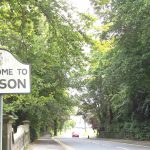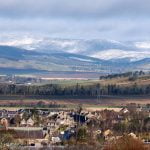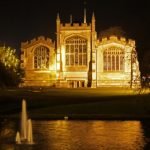
Five Minutes Spare Visits Northampton
Northampton is one of Englands Biggest Market Towns, steeped in history, located on the River Nene, and home to the world-famous Church’s hand made shoes. Throw in it has a football team and the fact it is close to Silverstone Formula One track and we just couldn’t resist. So let’s take the Five Minutes Spare tour of Northampton and get to know this Town a little bit better.
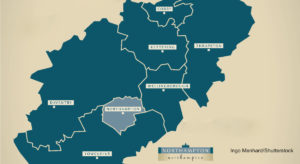
What’s in a name?
Rumour has it that this place was named Hampton, but there were already so many other Hamptons around that they change it to North Hampton. Although first conceived in Anglo-Saxon times and a Danish stronghold; this great market town still thrives to this day. Northampton is on the Nene, some 60 miles to the north and west of London.
Over the years, Northampton has survived a civil war, a great fire, 2 medieval battles, and various ages. It is thought to have begun back in the Bronze Age – but other sources put it as a Danish Bur after the Vikings came. A Bur is a fortress surrounded by what is essentially a moat but isn’t necessarily filled with water. A bur would normally also have a circular barrier around it to keep out wild animals in the night.
Early Northampton
It is generally agreed by historians that Northampton as we now know it wasn’t always the same. It was a collection of towns and villages, some of which had been in use since Neolithic times. In the Briar Hill area of town, remains were found to that effect. By the Iron Age, the people had turned it into a fort, which would have been in place around the Roman invasion circa 80 AD. The All Saints Church is thought to date from the 7th Century and for much of the 800s Century, Northampton was part of the Danlagh region
However, in 918 Edward the Elder reclaimed the town from the Danes, but it remained subject to Viking raids and in 1010 it was burned down by them. By the time of the Domesday Survey in 1080, it was recorded as being a notable town, large enough to be the centre of a borough, and this led to it getting its first castle in 1084 built by the towns first Earl Siimon De Senlis. Northampton was now firmly on the map and in the 12th Century, it was deemed significantly important to have its own mint!
Funnily enough and very much contrary to the modern-day, Northampton was considered the strategic capital of England during the Norman Conquest. This is where they had meetings and left armies in wait. Northampton Castle was built only 4 short years after the Domesday Survey was completed. In 1205 the evil King John from the tales of Robin Hood moved the treasury here and thirty-two meetings of parliament were conducted in the castle! This went on until 1380; when the introduction of mandatory poll tax forced them back to London.
The town walls were built at around the same time as the castle, although no longer standing, the walls served as protection through the ages. The Cluniac Priory of St Andrews was established and All Hallows Church – all erected by Simon de Senlis. This man went on to become the first Earl of the town. He was very religious, incorporating several priories into the local area. There was also a medieval poor man’s hospital, where those that could not afford medicine could be treated.
All in all, the Medieval version of Northampton was pretty progressive.
By 1189 then King Richard I granted the town a charter, allowing them to collect their own taxes and it is thought that around this time, the network of tunnels under the town was built, although we can’t be sure the two are connected (ok bad pun). After Richard passed his replacement King John appointed the first mayor in 1215, making Northampton only the fourth town in England to have one.
Around this time Northampton had a thriving market community. Wool was woven, shaped, and dyed here. Shoemakers, horse breeders and fine cloth makers all worked here. There was also a thriving religious community as instilled by the first Earl. It was a successful marketplace because of its location on the map. As a sort of half-way point between the midlands and London, it was an easy meeting place for most regions. St Andrew’s Priory was followed by Delamere Abbey in 1145. The Franciscan monks came to Northampton, and from here, they travelled the globe, spreading their message. They would also heal the sick, help the poor where they could, and distribute alms. Things were going well.
However, all good things tend to come to an end and in this case, it was a shuddering one. After such brilliant success, the people of Northampton got a little too big for their boots (ok yet another shoe reference). They elected to get involved in both of the Barons Wars against the crown and were promptly raided and sacked by royalist armies on two separate occasions. before the town had fully recovered the dastardly Black Death arrived and promptly killed off over half of the population. By 1377 the population of the town was down to 2,200 and its importance had begun to wane.
By the start of the fourteenth century, the town was a shadow of its former self. Northampton’s reputation would take a while to rebuild.
Northampton in the Middle Ages
Things took a while to get better with the great fire of Northampton which occurred in 1516 devastating the town, most of the then-wooden houses were burned to the ground thanks to the thatched roofing which easily spread the fire. The net result, many homeless people. The War of the Roses saw the first Battle of Northampton take place in the meadows near the river. Henry VI was taken prisoner here and few kings later, his descendants dissolved the monasteries… You can imagine how this affected the friar-heavy Northampton. If that wasn’t enough 1638 brought another bout of plague effectively wiped out another significant swath of the local population.
During the next civil war (because we keep having them) the town supported Cromwell and parliament probably due to them getting the army’s boot and shoe order which was estimated at around 6,600 pairs in total. The corporation that ran the town repeatedly refused the king’s orders and in 1642 they flat-out refused to pay the ship money tax. They petitioned parliament against papists and bishops, so it was safe to say religious sentiment had swayed somewhat by then. Still, they did keep the military footwear contracts and the town made millions of pairs during WWI.
In 1645 Cromwell visited the town before defeating the royal army in nearby Naseby. Interestingly, Northampton was well known for shoemaking by that point and outfitted the shoes for the entire army! It wasn’t all successes though. When England became a commonwealth the town was forced to pay for its charter. All of the local nobles were also forced to swear allegiance again…a fine price to pay for their loyalty.
In 1675 another fire broke out because nobody had learned their lessons from the first time and had rebuilt the town with wooden, thatched properties. Three-quarters of the town was burned to the ground within a single day. That’s 600 buildings destroyed, resulting in an Act of Parliament being issued to rebuild the town. The local peoples raised £25k towards the rebuild which remains a lovely historical moment of town pride and community spirit.
18th – Early 19th Century Northampton
In 1741 the first water-driven cotton mill was opened in Northampton. A few years later the barracks were built, and ever-after there have been soldiers stationed here. By the turn of the 18th century, shoemaking had experienced a resurgence and the town became well known for leatherworking, yet again. In 1815 the Grand Union Canal reached the town via the River Nene and the good times returned. By 1831 the population was over 15,000 people, not huge by today’s standards but more than double the population in 1801 and a quantum leap from the 2,200 that were left in 1377!
Again, the textile industry spurred on the growth of the leatherworking industry… who were spurred on by the fact that England kept going to war and armies march on their boot-clad feet as much as on their stomachs! It is true to say that Northampton were huge beneficiaries of the Napoleonic wars possibly why they chose French & German towns to twin with. Growth & trade were further boosted as 1845 saw the railway reach town via the line to Peterborough and in 1859 the towns current station “Castle Station” was opened. In 1842, they volunteered to become the parliamentary garrison town.
Let There Be Light
Gaslighting was introduced at the beginning of the 19th century. The gas lights were quickly followed by the lunatic asylum which poet John Clare ended up in, and Trams and a Library were added. Around this time water pipelines and sewers were also built, which did help prevent future outbreaks of disease (yay no more plague). By 1901 the population was over 87,000, however, the growth had been focused around shoemaking and not textile working like in other towns of this era. This may have ended up as a blessing as textile mills needed several hundred closely located staff to work them while shoemakers were generally less labour intensive. It is speculated that this is why Northampton never developed the horrid slums that other large towns suffered from. Despite this though more than half of all the workers in town belonged to the shoemaking industry by the late 1800s.
Northampton Gets a Cattle Market
Around the 1870s the town’s economy began to change a little when a cattle market came to town, providing more jobs for the laymen and brewing became more popular, making Northampton a little different from your average English Industrial Revolution town.
The turn of the century saw electric lighting replace the old gas lamps and around this time the trams were electrified, too. The local economy also began to change further with the end of the First World War meaning there was no longer the need to fit soldiers with millions of pairs of boots. Thus the shoemaking industry began to go into decline and by the end of WWII, the town began to change with a broader sphere of industries now prevalent. Loads of London residents moved here to get away from the smog and it became a commuter town for the capital, with swifter and swifter rail services allowing everyone to work on time. The final part of the growth splurge came with the designation of Northampton as a New Town in 1968 and the population has grown significantly.
Modern Northampton
Nowadays, Northampton is thought to have a population of around 225,000 6% higher than in the 2011 census and a far cry from the 1971 figure of 133,800. This exponential growth has come on the back of service industries, with distribution and financial services now being significant employers. The commodity shoemaking industry no longer exists but bespoke and hand made manufacturers still thrive and of course, with it having such a huge market square retail also plays its part.
It is now firmly within the London commuter belt and home to the Diocese of Northampton, who reside in the town’s Cathedral. This Diocese not only covers Northamptonshire but also Bedfordshire & Buckinghamshire and is a hark back to the towns religious roots. It is also the seat of the local County Council, although this may change post-2021 when the structures is set to change to two unitary district councils.
So there we have it a potted history and now for a few facts before we hit the attractions…
Famous People from Northampton

Comedian Alan Carr grew up in the town and his dad played for and managed Northampton Town FC!
Image Featureflash Photo Agency/ Shutterstock.com
Northampton has contributed far more than shoes & a football team over the years. There are several famous faces that originate from this area. Some of Five Minutes Spares favourite famous people linked to Northampton include:
- Comedian Alan Carr, although born in Weymouth, spent most of his childhood in Northampton. Better yet, his father played for Northampton Town Football Club in the 1960s (85 appearances) and went on to manage them in the mid-1980s from while the family lived there.
- On a less cheerful note, we have John Clare the “Northamptonshire Peasant Poet” and essayist who was eventually interned (and ultimately died) in Northampton Lunatic Asylum. The asylum no longer exists… they rebranded it as St Andrew’s Hospital…
- Nobel prize-winning Francis Crick is one smart cookie out of Northampton who is responsible for some pioneering work on Molecular Biology.
- Michael Crick – no relation – who was one of the founders of Channel Four!
- Actor and Comedian Tim Minchin (Friar Tuck in the 2018 version of Robin Hood) is a Northampton resident.
- Pat McGrath MBE and brilliant makeup artist was born here. Apparently she can make a Sow’s ear look beautiful – well probably not but she is one of the worlds most in-demand makeup artists.
As you can see, residents of Northampton have managed to impact all walks of life… from micro-biology to making the world a more beautiful place!
Fun Facts about Northampton
It’s not all doom and gloom, either. There are some lovely little things in Northampton’s history that deserve to be remembered. Some of the Five Minutes Spare favourites are:
- Silverstone – the noted, world-famous Formula 1 Racing Circuit, built on the site of the local World War II Royal Air Force bomber station. Its modern-day capacity is 150,000 so you should get in easily enough and to the best of our knowledge, there are no unexploded bombs still lying around. There is a direct line from Northampton Train Station.
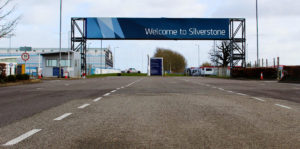
- The world’s first RADAR display happened in Northampton in 1935. It was given by Robert Watson-Watt, a pioneer in the field.

Image:your/Shutterstock.com
- It has the biggest market square in England. It was originally built in 1189 but was widened when the town was rebuilt after the second fire.
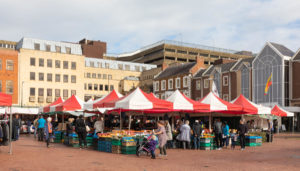
If Markets are your thing then you will love browsing this one!
Image Credit: Adrian Chandler /Shutterstock.com
- Shoes have been made in Northampton for more than 900 years – as a result of good positioning, leather has always been readily available here given the local oak forests (oak bark was essential in the early tanning process). Many a million soldiers have marched into battle clad in Northampton footwear.
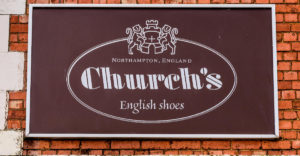
World-famous Shoe Maker Church’s was founded in Northampton in 1873 and still operate there today.
Anything Else to Know?
Well although it was designated a new town in 1968 it still doesn’t have city status. They have previously applied but been turned down. However, they are applying for the City of Culture award in 2029 so this could change.
How about twinning… Yes like virtually every town, city and even village, Northampton has its Twin. Well, two, in this case, being conjoined with:
Marburg – a somewhat smaller town in the Hesse region of Germany.
Poitiers – in France, who are themselves taking twinning to a new level having seven twins (sextuplets anyone)!
So overall our view is that Northampton is a brilliant place to visit … even if the majority of the shoemakers are gone. It is full of historical significance and you will have to be very hard to please not to find something you like in its bounds. If you live nearby or if you are looking for an English tourist destination that’s a little off-the-beaten-track, we can’t recommend it enough. Let’s look at the attractions next, to prove it to you!
Northampton Attractions
Wondering what to get up to in Northampton? We can help!
Historic Attractions and Landmarks
First and foremost; Charles Rennie Mackintosh designed a renovated building at 78 Derogate. It is a Grade II listed structure that Mackintosh worked on for a friend. It was also a Georgian house, built all the way back in 1915. It is thought to be the first of its kind in the British Isles. Well worth a visit for art lovers. Also for food lovers, since someone added a restaurant!
A second landmark attraction is the Spencer Estate. Known as Althorp House, this 550-acre estate is open to the public. It was built in 1508 and has been added to several times over the years. It makes for a fascinating day out in beautifully kept surroundings.
The third historic building we advise you to see in the area is the Delapre Abbey. This place was a nunnery, so you can imagine some of the horrors it has seen over the years. Back in the day, noblewomen who had brought shame to the family would be sent to a place like this. Now it is filled only with people who want to be there… and it is stunning in high summer.
Religious Attractions
For those who cherish the religious heritage here in England, head on over to the All Saints Church, which has been serving the parishioners of the town in one guise or another since medieval times. Being located in a prominent position in the town centre, this Grade I listed building is a good place to start any sightseeing tour. It is open to visitors most days both for worship or a general look around. A visit is well worth it as it has some fine architecture and a very impressive church organ. American visitors will be interested to know that there are also some links to their country and in particular their inaugural President George Washington!
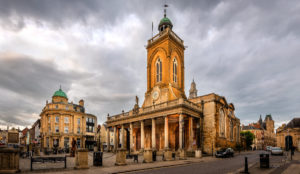
The Imposing All Saints Church is a good starting point for any tour of the town.
Image: SAKhanPhotography/Shutterstock.com.
If you want to go on an Old English style pilgrimage, add Northampton to your tour and also add in visits to the Cathedral of Our Lady & St. Thomas, St. Giles Church, St Peter’s Church, St Matthew’s Church, The Church of the Holy Sepulchre… We’re going to stop there…
If you fancy a bit of an extended tour on a similar vein then you could do the Queen Elenor Cross trek which from North to South begins at Lincoln and takes in Grantham, Stamford, Geddington,
Northampton (Hardingstone on its outskirts to be precise), Stony Stratford, Woburn, Dunstable, St Albans, Waltham Cross, Cheapside and finishes at Charing Cross. Best bring your car for this one though.
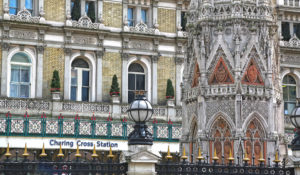
The Eleanor Cross outside Charing Cross railway station the most Southern of the 12.
Image:Luziana5588/Shutterstock.com
Nature and Parks
The Rookery Open Farm is an awesome outdoor attraction in Northampton that is great fun for the kiddies. It has a picnic area, an enclosed adventure playground outside – but a three-story soft/adventure play barn on the inside. There is a petting zoo to enjoy, or you can enjoy the tearoom and let the little ones run free for a while.
Although technically a historic manor house, Lamport Hall is best known for its gardens. For this reason, we popped it in the nature section. It is rumoured to have one of the best gardens in the UK, and regularly holds events. In May they hold a festival of all things garden and it is a true sight to behold for the flower lover. They run tours on the first Wednesday of each month. A little obscure perhaps, but totally worth it. There’s also the house, too, which was built in the 16th century by a rich wool merchant…
Sport
Rugby Union, Cricket & Football are all represented at a professional level within the town with all three being able to trace their roots back into the 1800s.
The Northampton Saints RFC
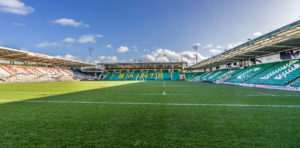
Franklin’s Gardens The Saints Home Stadium.
Image: Gordon Bell/Shutterstock.com
The Northampton Saints represent the Town in Rugby Union and they, at the time of writing (2020) play in the English Premiership and were champions as recently as 2013-14 season. However, their main claim to fame was their victory in the Heineken Cup in 2000 (now the European Rugby Champions Cup). They have won the tournament twice since however, that first win remains sweet with the fans. Their home stadium is the purpose-built Franklin’s Gardens which is conveniently situated for both the Bus & Railway Stations. Capacity is around 15,250, however, unless they are playing biter rivals such as the Leicester Tigers, Saracens or Wasps you should be able to get a ticket on the day.
Northamptonshire County Cricket Club
If Cricket is your game (or you are more of a summer sports person) then you are in for a treat. The club which was founded way back in 1878 plays at the highest level of English Cricket and has been home club to a host of international stars including Wisden 2007 Cricketer of the year Monty Panesar. They play at the County Ground which they used to share with Northampton Town FC which is located in the Abington area of the town.
Northampton Town Football Club.
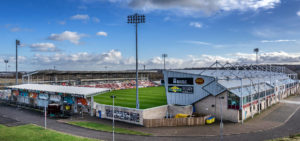
Sixfields Stadium current home ground of Northampton Town
Image: Gordon Bell/Shutterstock.com
Northampton Town FC or the “Cobblers” as most fans know them are the towns football league representatives. They were formed back in 1897 and currently play in League Two. As mentioned above they used to ground share with the Cricket Club (meaning they had an open side which was not ideal), but since 1994 have played at the Sixfields Stadium. They joined the Football league in the 1929-30 season and the 1960s holds bittersweet memories for long term fans. The club won the Fourth Division title in 1960-1 and in a quite meteoric rise found themselves in the top tier of English Football in the 1965-66 season! Sadly this didn’t last long and they were relegated that year and they were playing in the fourth tier again by the 1969-70 season. They have never been above the third tier since but they will always remember that season!
Anyway if you fancy taking in a game then you should be ok visiting on the day as Sixfields can hold 7798 fans at capacity and this has only sold out once – when Manchester United came to visit in 2016. Still, if you are making the journey especially it would be worth buying a ticket in advance.
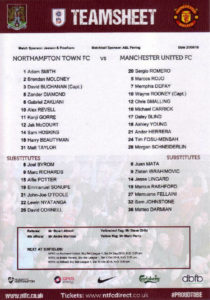
Team Sheet from The Sell Out League Cup Meeting. Sadly no fairy tale as Man Utd won 3-1
If you are a fan of more grassroots football then there are a couple of non-league teams based within the town, both of whom play in the United Counties League:
Northampton Sileby Rangers F.C & Northampton Old Northamptonian Chenecks F.C.
Golf Anyone?
If you fancy a quick 18 holes then Collingtree Park Golf Club is your best bet, its open to visitors but bear in mind it does have a dress code so if you decide to drive a few balls please show some respect and turn up suitably attired. You can check this out here.
Gone but not forgotten…
If you are lucky enough to be the proud owner of a DeLorean shaped time machine then feel free to go back to the 31st October 1964 and enjoy the last ever Greyhound racing in the town, or if Speedway is more your game then set the dial for 1930 as they only had two seasons of it. Who knows maybe someday they will bring these two back?
What is more likely to return is the Northampton Museum and Art Gallery run by the Local Borough Council according to their web site it is due to return in 2020 so watch this space! It is something we are looking forward to as it used to be famed for… Yes, you guessed it one of the worlds the largest collection of shoes – over 12,000 pairs! That’s a lot of polishing!
Shopping!
Some of us go on holiday to shop and that is absolutely OK. There is nothing to be ashamed of here! The Heart of the Shires is a quaint little shopping ‘village’ that you will find amusing. There are lots of boutique-type stores so it may be best for those with a lot of disposable income. For something in a mid-range price go for Sol Central; if you want budget shopping near Northampton head to Nene Court. They have enough shops for everyone. We also hear tell that it is a good town for antiquing.
Where to Eat, Drink and Party in Northampton?
If you are looking to impress with culinary knowledge: try the Hibiscus. If you are going on a date and don’t want him/her to order the lobster, Number 50 is quite good for the price. If you want somewhere you don’t need to move from to get drinking, the Hungry Horse is a safe bet.
For partying the night away try the Beer guerrilla. They have all the different ales you could ask for. G&T’s is a really lively lounge bar for later evenings though.
Other Notable Attractions
There are so many attractions in this fantastic place that we can’t fit it all into one article. We can summarise though! Here are some of the other notable attractions and things to do in Northampton. Get stuck in!
- Northampton Guildhall – those that like landmark spotting will get some Instagram worthy shots at this gorgeous old building. You can get tours throughout the day.
- All Saint’s Church – this stunning building includes a tower that dates back to Saxon times. It doesn’t offer much more than a seat and a friendly face to talk to – but the history is worth a visit.
- The National Lift Tower – you will be able to see this one from all over Northampton. It is a monument to lifts, although it was once an elevator testing facility.
Let’s not forget the little ones either. Some of the best things to do in Northampton with Kids include:
- Abington Park – this place is huge, with a picnic area and plenty of walks and play areas. Take the kids for a free day’s entertainment. It also has a rather nice Museum which is well worth a visit especially if you are a Shakespeare buff as the Grade 1 listed building which houses it was once home to his granddaughter. CIt has some nice displays relating to the Northamptonshire Regiment and the history of Leathercraft.
- The Pinnacle Climbing Centre – Has various climbing halls with over 200 routes, some of which reach up to 12.5 meters high, Don’t worry though they also have mini, child-friendly climbing walls. It’s great fun and you get to watch from a safe distance if you have vertigo.
- Head out to Wicksteed Park – it is a theme park designed for kids but with enough to do to keep the whole family happy. It can be traced back to 1921 and today the park covers around 147 acres of parkland, lakes and ponds. It even has a campsite with a shower block and toilets, so you don’t have to totally rough it.
Head on out and have some fun!
How to get there?
We have nearly finished our guide to Northampton – but you still need to know how to get there!
By Road
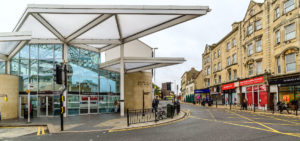
North Gate Bus Station offers good transport links with the surrounding area and connections further afield.
Image: Jevanto Productions/Shutterstock.com
Whether travelling north or south through the UK, the M1 will get you there. Leave London heading north-west and you won’t miss it. The town also has a bus station which is located on Bradshaw Street, just off Market Square which has links to many parts of the region including to Leicester and Bedford which both open up connections to the North & South of the country. North Gate Bus station is pretty impressive with 14 departure bays as well as shops and even a cafe so you can grab some light refreshment before setting off on your journey.
By Rail
Northampton Station is today almost unrecognisable from the ramshackle shed it was in the 1960s and the upgrade is estimated to have cost around the £20 million mark. Even if trains are not your thing knowing how much they spent on it make you want to see it… Right?
By Sea
Northampton is landlocked but is on the River Nene and connected to the Grand Union Canal via the Northampton arm so we suppose if you were determined and ingenious enough you could potentially reach it from the sea (the phrase we are going to need a smaller boat comes to mind). Anyway, this route is probably best left to some future reality TV show. However, if you have a houseboat you could probably visit the town from any other town or city on the canal network.
By Air
The provincial (but immortalised in a song) Luton Airport is your nearest big airport. It is only an hour or so by train and has good road links.
Got Five Minutes?
Enjoy this guide to Northampton but still want more? We don’t blame you. Some of our guides are downright hilarious. You can find a whole host of interesting trivia just waiting for you to dive into, over at Five Minutes Spare HQ. So jump in, have fun, and don’t blame us if you don’t get any sleep tonight for scrolling!

